New Light on Adult Literacy and Numeracy in Scotland: Evidence from the 2004 survey of the 1970 British Cohort Study (BCS70)
This report gives the results of a separate analysis for Scotland of literacy and numeracy data collected in the 1970 British Cohort Study at age 34. It relates performance in these skills to a wide range of other features of Scottish cohort members' lives.
Chapter 9 Family life and well-being
In this Chapter we look at the average age men and women had their first live-in relationship, their first child and their current family situation at age 34. We also cover physical and mental well-being together with health related practices such as exercise, smoking and alcohol consumption.
Relationships and parenthood
First live-in partnership
To further emphasise the different moves to independent living by men and women in the different skills groups, we look at age of first living with a partner. At age 34, nearly 1 in 5 of all men (19%) and 1 in 7 of all women (14%) had never lived with a partner. For both men and women this was highest amongst those with SCQF Access Level 2 or 3 literacy - 25% men and 21% women.
Early live-in partnerships were more than twice as likely among women as men. For example, 15% of all women and 6% of all men had first lived with a partner while still a teenager. By age 21 this had increased to 38% of women and 21% of men.
For women early live-in partnerships were more commonplace among those with SCQF Access Level skills. For example 24% of women with SCQF Access Level 2 or 3 literacy skills had first moved in with their partner while still a teenager compared with 11% of women with SCQF Level 5 or higher skills. Similar differences were apparent across numeracy groups (20% SCQF Access Level 2, 22% SCQF Access Level 3, 10% SCQF Level 5 or higher skills). There were no differences across literacy groups for men, but men with SCQF Access Level 2 numeracy skills were more than twice as likely as men with SCQF Level 5 or higher numeracy to have first lived with a partner as a teenager (10% to 4%).
Marriage
Two-thirds of men and women were, or had been, married at age 34. Most likely to have married were women with SCQF Level 5 or higher numeracy (75%); least likely were men with SCQF Access Level 2 numeracy (47%) or men and women with SCQF Access Level 2 or 3 literacy (41% men, 42% women).
Family living at age 34
At age 34 around 1 in 6 men with SCQF Access Level 2 or 3 literacy or SCQF Access Level 2 numeracy lived with their parent(s) compared with less than 1 in 10 men with SCQF Level 5 literacy and 1 in 13 men with SCQF Level 5 numeracy. No more than 1 in 25 women (4%) lived with one or other parent at age 34. Just over half of all men and women (56% men, 58% women) lived with their partner and child/children. 1% of men and 13% of women were living as a single parent. Levels did not differ across groups for men or for women by literacy, but women with SCQF Level 5 numeracy were half as likely as women with SCQF Access Level 2 or 3 numeracy to be bringing up children on their own (15% SCQF Access Level 2, 19% SCQF Access Level 3 and 8% SCQF Level 5).
Becoming a parent
By age 34 44% of men had yet to become a father, with teenage parenthood - or the reporting of being a teenage father - being a relatively rare event at just 2%. However, by age 20, 8% of men with SCQF Access Level 2 or 3 literacy and 6% with SCQF Access Level 2 numeracy had become a father for the first time compared with 4% of men with SCQF Level 5 or higher literacy and 1% with SCQF Level 5 numeracy. By age 34 8% of all men had 3 or more children being only marginally higher for men with SCQF Access Level literacy.
The earlier transition to parenthood is far more apparent for women. Around 1 in 3 of all women had not had a baby by age 34 but women with SCQF Access Level skills were the most likely to have become a mother. Figure 9.1 shows that women with SCQF Access Level 2 or 3 literacy were more than four times more likely to have been a teenage mother as women with SCQF Level 5 or higher literacy (24% to 5%). Women with SCQF Access Level 2 numeracy were six times more likely to have been a teenage mother compared with women with SCQF Level 5 or higher numeracy (18% to 3%). By age 21, 9% of women with SCQF Access Level 2 or 3 literacy had two or more children compared with just 1% of women with SCQF Level 5 or higher literacy. No women with SCQF Level 5 or higher numeracy had 2 or more children by age 21 compared with 5% of women with SCQF Access Level 2 numeracy.
Figure 9.1 % women who had their first baby as a teenager by grasp of literacy or numeracy
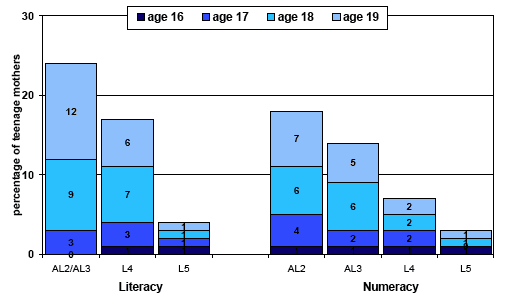
The differences for women across skills groups continued to be very apparent as the cohort grew into their thirties. Figure 9.2 shows that by the time cohort members reached age 34 women with SCQF Access Level 2 or 3 literacy were more than three times as likely as women with SCQF Level 4 or higher skills to have 3 or more children (29% to 8%), with 9% having 4 or more children. 5% of women with SCQF Access Level 2 numeracy also had four or more children compared with no more than 1% of women with SCQF Level 5 or higher skills.
Different partnerships
A possible indicator of a less stable family environment is the number of partners a cohort member has had, or more specifically, how many of their children are a result of different partnership formations. Among men, 5% had children from two different relationships but there were no differences across groups. However, numbers were small, as nearly half of all men had not yet fathered a baby. For women, although those with SCQF Access Level 2 or 3 literacy or SCQF Access Level 2 numeracy were more than twice as likely as women with SCQF Level 5 or higher numeracy skills to have had children with more than one partner, overall levels were low. Just 11% with SCQF Access Level 2 or 3 literacy and SCQF Access Level 2 numeracy skills had children with more than one partner, compared with 7% with SCQF Level 5 or higher literacy and 3% with SCQF Level 5 or higher numeracy. It is likely that the figures will even out later as women with higher level skills entered parenthood at a later age.
Figure 9.2 % women with 3+ children at age 34 by grasp of literacy or numeracy
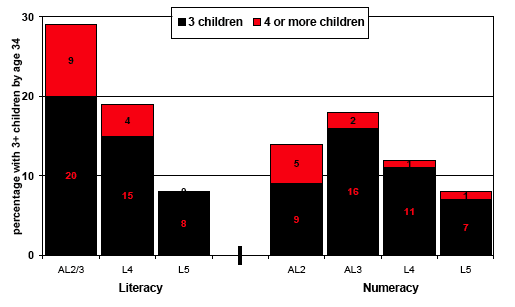
Health and well being
Relatively poor physical health and mental well-being were associated with poor literacy and numeracy. Compared to women with SCQF Level 5 skills, Figure 9.3 shows that women with SCQF Access Level 2 or 3 literacy or SCQF Access Level 2 numeracy were most likely to report having a long standing illness (44% to 25% literacy, 42% to 18% numeracy), and that their general health limited their everyday activities (27% to 7% literacy, 18% to 4% numeracy). Calculation of cohort members Body Mass Index ( BMI) placed 6 in 10 men and 4 in 10 women in Scotland as overweight or obese. Compared with men and women with SCQF Level 5 or higher skills, this was slightly more likely among men and women with the poorest grasp of literacy (64% to 58% men, 48% to 42%) or numeracy (65% to 57% men, 50% to 42% women).
Figure 9.3: women reporting a long standing illness or that their health limits their daily activities by literacy or numeracy
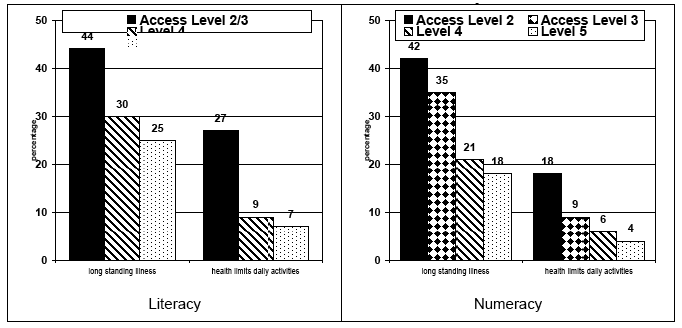
Health related practices
Low skills were also related to poor health-related practices. Figure 9.4 shows women with SCQF Access Level literacy or numeracy were more than twice as likely as women with SCQF Level 5 skills to smoke every day (47% to 22% literacy, 42% SCQF Access Level 2, 34% SCQF Access Level 3, 15% SCQF Level 5 numeracy). Similar but less pronounced differences were apparent between men. Consumption of alcohol also differed across groups, particularly for men. Figure 9.5 shows that whereas men (and to a lesser extent women) with better skills were most likely to report drinking alcohol on two or more days a week, men with poor skills, particularly SCQF Access Level 2 or 3 literacy, were more likely to consume more units of alcohol when they drank. As many as 1 in 3 consumed more than 40 units of alcohol in a week compared with 17% of men with SCQF Level 5 of higher skills.
Figure 9.4 % men and women smoking daily by literacy or numeracy
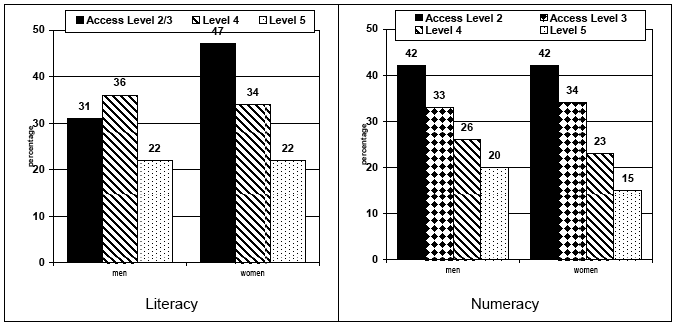
Figure 9.5 how often and how many units men drink in an average week by literacy or numeracy
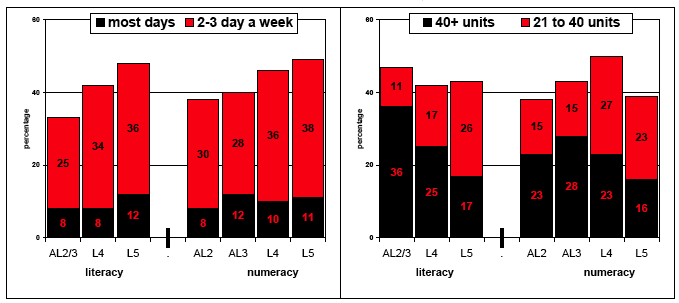
Psychological well-being
Figure 9.6 shows that more than 1 in 4 men and women with SCQF Access Level 2 or 3 literacy or SCQF Access Level 2 numeracy reported four or more symptoms of depression out of a maximum of nine questions that formed a shortened version of the Malaise Inventory 33, around twice that of men and women with SCQF Level 5 skills. From Figure 9.6 we can also see that SCQF Access Level 2 men and women were more than twice as likely to feel that they 'never got what they wanted from life' and up to four times as many felt that 'whatever they did had no effect on what happened to them' compared with those with SCQF Level 5 skills. Differences were most marked among men, being highest for the men and women with the poorest grasp of literacy.
Figure 9.6 Relationship between literacy, numeracy, depression and psychological well being
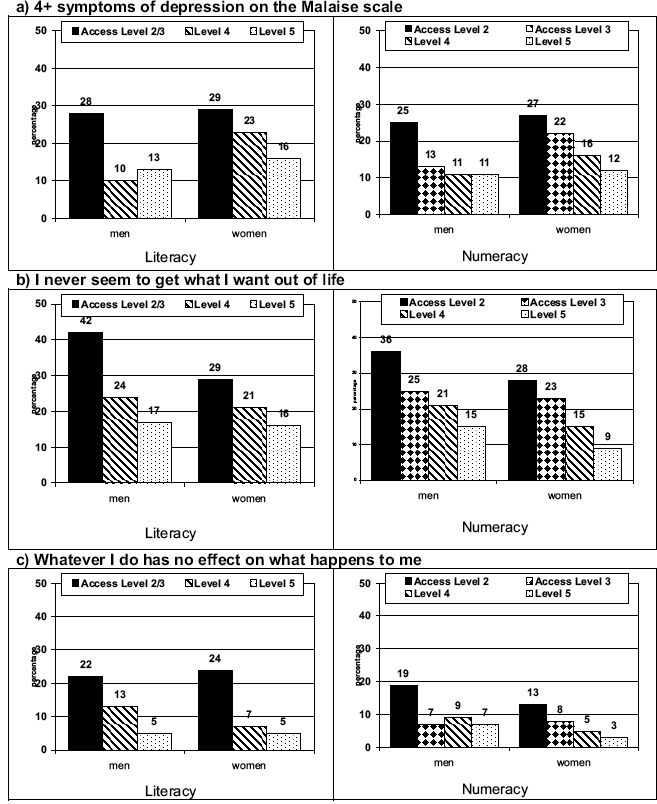
Summary family life and well-being
Men with SCQF Access Level literacy or SCQF Access Level 2 numeracy were the most likely to be living with one or other of their parents at age 34. More of the men and women with SCQF Access Level literacy had never lived with a partner by age 34, but equally, women with poor literacy skills were also the most likely to have first moved in with a partner when still a teenager and to have become a teenage mother (24% to 5% with SCQF Level 5 or higher literacy). They went on to have further children, with three or four children not being uncommon by age 34 (29% to 8% with SCQF Level 5 or higher literacy). It seems that although as many as 1 in 5 women with SCQF Access Level literacy did not form (live-in) partnerships by age 34, the majority began the transition to partnership forming and family life earlier than women with a better grasp of literacy.
Poor physical and mental well-being together with poor health related practices were also associated with men and women with the poorest grasp of literacy or numeracy. More of these men and women had symptoms associated with depression (28% men and 29% women with SCQF Access Level literacy compared with 13% men and 16% women with SCQF Level 5 or higher literacy). They were also more likely to report to never get what they want out of life (42% men and 29% women with SCQF Access Level literacy compared with 17% men and 16% women with SCQF Level 5 or higher literacy), and that their health limited their daily activities in some way. They were more likely to smoke cigarettes every day, and men who drank alcohol were also more likely to consume a higher number of units than men with higher skills.
There is a problem
Thanks for your feedback